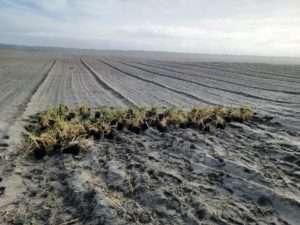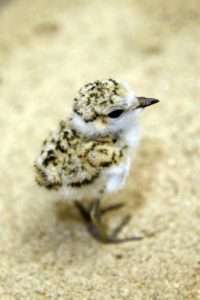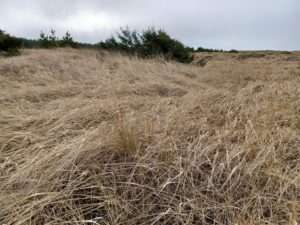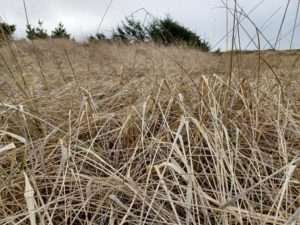
I love sleep, and I love not having to wake to an alarm. It’s one of my favorite things about my current occupation. But yesterday I made an exception, and got up extra-early (alarm included) so I could take part in habitat restoration up on Leadbetter Point with staff and other volunteers from Willapa National Wildlife Refuge. The goal? Continue habitat restoration efforts in an area where invasive beach grass had been removed by planting 300 pots of the native species.
So What’s the Difference?
Here’s something a lot of people on the west coast don’t know: all those thick swathes of beach grass you see along the coastline from central California all the way up into British Columbia aren’t supposed to be here. There are two species of invasive beach grass, European (Ammophila arenaria) and American (Ammophila brevigulata). The latter is probably better called Atlantic beach grass, since that’s its primary range, though it is also native to some shorelines of the Great Lakes. In their native habitats they help to stabilize and build sand dunes, and other species in the area have adapted to competing with or making use of these grasses.

Unlike these Ammophila species, our native beach grasses like American dune grass (Leymus mollis mollis or Elymus mollis mollis) and tufted hair grass (Dechampsia caesposita var. longiflora) don’t create endless waves of monocultured fields. Rather, they grow in clumps here and there, with plenty of sand in between. This allows other dune plants like yellow sand verbena (Abronia latifolia) and the very rare pink sand verbena (Abronia umbellata), yarrow (Achillea millefolium), pearly everlasting (Anaphilis margaritacea), and seashore lupine (Lupinus littoralis) to flourish.

The presence of greater plant biodiversity allows for more insects and other arthropods, which are important pollinators and the backbone of the food web. The open sand also creates crucial nesting sites for threatened birds like the western snowy plover (Charadrius nivosus nivosus) and the streaked horned lark (Eremophila alpestris strigata), the latter of which has been described as “the most endangered bird in Washington“.
Unfortunately, the early and middle 20th century saw the deliberate planting of both invasive Ammophila grass species all along the Pacific coastline. Intended to keep dune sand from drifting into the homes and businesses along the beach, it quickly spread outside of its original bounds, and over the past few decades has completely overrun most shorelines. As if this wasn’t trouble enough, the two Ammophila species are now hybridizing in Oregon and Washington, creating a third variant that could be even more hardy. But why is this a problem? Grass is grass, right?
March of the Invasive Beach Grass

Not really. It primarily comes down to the growth patterns of the native versus invasive beach grass species. Because Ammophila grasses cover as much ground as they can, with little room to spare, they crowd out the other plant species native to the area. This means fewer food sources for native wildlife, which can lead to the complete collapse of the dune ecosystem. While the beaches along the Long Beach Peninsula may seem to be active, with many gulls and shorebirds right along the water, the dunes themselves are practically ghost towns compared to the diversity of species they once harbored. Only a few hardy dune plants manage to eke out an existence around the edges of the grass monocrops, and a few stunted sword ferns, shore pines, and evergreen huckleberries avoid being completely choked out in the middle of the fields of invaders.
Those shore pines are a vanguard of even worse news for the dunes. Because invasive beach grass holds dunes in place instead of letting them ebb and flow as native grasses do, they allow the shore pines to advance closer and closer to the ocean. This begins the ecological shift from dune ecosystem to forest. Comparisons of aerial photos of Leadbetter Point, located at the end of the peninsula, over the past several decades show that the shore pine forests have expanded north over two miles since the middle of the 20th century, aided by the invasive beach grass. Where the entire point used to be miles of rolling dunes, now there only remains a thin strip of beach around the edge. It’s a microcosm of the much larger problem that has destroyed native dune ecosystems all along the North American Pacific coastline.
The Threat of Fire
There’s another piece to the story, one that has been becoming more prominent in recent years as anthropogenic climate change has brought greater drought even to our normally rainy area, and Pacific Northwest fire seasons become longer and more severe. Historically the dune vegetation was a low enough density to not be highly flammable.

However, as invasive beach grasses were introduced, nothing kept them from growing far out of control. And because the invasive grass grows so thick and fast, and creates large fields with no space between plants, dry, dead vegetation built up very quickly. Now the dunes are covered with literally decades’ worth of highly flammable fire starter with no natural firebreaks left.
Add in the increasing number of tourists, the popularity of the peninsula as a place for people to gather from across the region to build bonfires and set off fireworks on the beach, and ocean breezes that can fan flames from a tiny fire to a huge conflagration in little time, it’s amazing we haven’t had more large, dangerous dune fires. While our local fire departments do an excellent job of responding to incidents, it’s really only a matter of time before something gets out of control on these increasingly hot, dry summer days. And there are many houses and businesses built near and even in the dunes.
Turning the Tide on Invasive Beach Grass
Which is why yesterday’s planting activities are so important. The staff and volunteers at Willapa National Wildlife Refuge have been working for years to restore habitats all across Refuge lands, from wetlands to meadows, and of course the dunes. We were working at the latest location where Refuge staff used heavy earth-moving equipment to bulldoze and bury 150 acres of invasive beach grass in late January. When we arrived, it was almost disorienting to see so much land laid bare, without the endless waves of invaders. But it was also thrilling, and made me a little giddy, for this was the first step in bringing back the native dune ecosystem that had been all but exterminated in the last few decades.
The next step, of course, was to start bringing back the native plants. And we were laying the foundation with 300 gallon pots of Leymus mollis mollis. Though most were less than a foot high, they were healthy, and their roots were eager to spread out into larger spaces. With a team of three staff members, and three volunteers in addition to me, we set out to get these pioneers planted in two separate locations.

Thankfully, many hands made light work, and we had the job done in less than three hours. It didn’t hurt that we had a perfect day for it, just enough cloud cover to shield us from bright sunlight, and a cool ocean breeze that wasn’t quite enough to keep us from removing our coats once we got warmed up. The Refuge biologist on hand explained how these first plants would go on to seed more patches across the open dunes, and later plantings would add more species like pearly everlasting and the two sand verbena species. With time, and careful hand-removal of any Ammophila attempting to return, this could be a showcase example of how to start to undo the massive amount of damage done by the invasive beach grass.
But we need to do more. We need to educate people about the story of the dunes, what has been lost and what could be regained. More importantly, we need to cultivate a mindset, both individually and culturally, that takes into account the ecological effects of our actions before we put them into play. Granted, we weren’t as aware of the effects of invasive species back when Ammophila started showing up on the wrong coast, but that was in part because few people had even considered that it might not be a great idea to add a species to an ecosystem it had never evolved in. When we think ahead and consider all the possibilities before we take action, we are more likely to head off these massive problems. It doesn’t mean we shouldn’t also put forth the effort to try to correct past errors, but it does hopefully mean we’ll have fewer messes to clean up in the future. After all, we’ve got our hands full to overflowing as it is–hands that can be used to plant a little hope into a southwest Washington sand dune.

Thank you for this information. I love when I see the native beach grass on my walks and when I am with other people I point it out. It is such a beautiful color, just glorious. I didn’t know it’s growing pattern though, and so you have explained why it is not plentiful. And I have also noticed the pearly everlasting along the trail where it is not drowned out by grass. The task of removing and replacing the grasses seems insurmountable. Thanks for working on this in a limited area. Is it ok to go take a look? I would love to see this area. Thank you again for your excellent explanation.
You’re very welcome! The area where we were working is near the beach end of the Bearberry Trail at Leadbetter; the trail is likely flooded through the woods, so you can also access it by driving out the Oysterville beach approach until you get to the “no cars” sign, then park, get out and walk less than half a mile to the restoration location.
When dune habitat is fully restored and the invasive grass is removed, you might be amazed and how many plant species you see there, to say nothing of the wildlife!